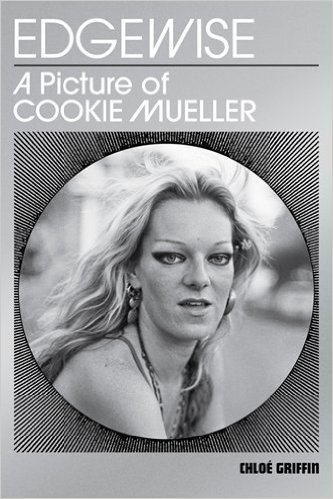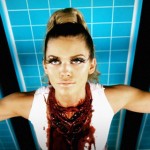Book Review: “Edgewise: A Picture of Cookie Mueller”
 Edgewise: A Picture of Cookie Mueller
Edgewise: A Picture of Cookie Mueller
by Chloé Griffin
Bbooks Verlag, 2014
336 pages
Available on Amazon HERE
You might know her as the girl in the chicken-fucking scene from John Waters’ “Pink Flamingos” (1972), but this largely explores another Cookie. The one Waters admitted was a better writer than actor. To give you an idea of her fashion sense and early filmic persona, she might have been perfectly at home tagging alongside Karen Black and Toni Basil in the New Orleans cemetery bummer acid trip scene from “Easy Rider” (1969), or made a good BFF to murderous drug-addled gang moll Sadie in “Last House on the Left” (1972). Whether or not her trademark lisp would’ve lent verity to those roles is another thing. The closest the chronically underground Cookie ever came to such relatively “mainstream” film gigs though was, as her typewritten 1980’s CV reprinted in “Edgewise: A Picture of Cookie Mueller” boasts; playing a hairdresser in a TV horror comedy skit called “Texas Chainsaw Manicurist.” But when the actual “Texas Chainsaw Massacre” director Tobe Hooper happened to catch it while casting “Texas Chainsaw Massacre 2,” her costar Bill Moseley got the call instead, hired on as the enduring fan-favorite “Chop Top.” Exhaustively researched and heavily illustrated, Chloé Griffin’s “Edgewise” is crammed with a wealth of such reprinted ephemera as Cookie’s diary entries, postcards, doodles, articles, scrapbook collages, letters, contact sheets, and even a few handwritten phonebook pages.
Griffin made labor-of-love pilgrimages to all of Cookie’s hotspots befriending as many of the people Cookie was close to that she could for interviews. Oral history “Edgewise” spans 4 decades, from Cookie’s childhood in Baltimore, her hippy days on the west coast where legend has it she jumped into Charles Manson’s van to smoke a joint, her beginnings as one of the original Dreamlanders, to her travels back and forth between Provincetown & New York City where she settled when things started slowing down with Waters. She was proto-punkin’ out in P-town with cabaret/musical act The B.B. Steele Review featuring Edie the Egg Lady singing “These Boots Are Made for Walking” contemporaneously with Debbie Harry’s first like-minded campy Max’s Kansas City-era band Elda and The Stilettos. She hooked up with Richard Hell for a romantic and collaborative artistic relationship just in time for No Wave Cinema, playing a masochist for his ex-con character to whip in Rachid Kerdouche’s “Final Reward” (1979). “To me, she’s always represented that ideal New York artist way of life,” Hell says. “When she walked into a bad party, she cured it.” Besides his reminiscences come countless anecdotes from lovers both male and female, family and friends, fellow writers, musicians, filmmakers, and artists the likes of Gary Indiana, Udo Kier, Taylor Mead, Pat Place, John Waters, Amos Poe, and even her son Max who she tried to raise throughout the chaotic zeitgeist that was her life, rebelling in his own way in the midst of the folks who wrote the book on rebellion. “My friends were thieves and graffiti writers,” Max explains on being arrested at 14 for stealing cans of spray-paint and a pack of hotdogs. But when they had nowhere else to go, they could always count on his mom to let them come over and smoke pot.
Cookie was a muse to many. She had several books under her belt, one of which inspired Chloé to write “Edgewise;” the revered collection of short stories “Walking Through Clear Water in a Pool Painted Black” published posthumously by Semiotext(e). Cookie also wrote prolifically for various magazines like Saturday Review of Literature, High Times, and even had a regular art column in Details. But like Richard Meltzer handing in fake record reviews about music he couldn’t be bothered to listen to, you had to keep an eagle eye on Cookie as she’d occasionally write about arts events she never even showed up for. She also had a “health column” in The East Village Eye called “Ask Dr. Mueller,” offering dubious advice, recommending, for example, that people with AIDS find a good chiropractor/nutritionist before any medication or therapy because friends of hers that did just that were “virtually cured.” Granted, AIDS in 1983 was still a mystery and she was “tired of going to wakes.” She succumbed herself in 1989, providing “Edgewise” with its most heartbreaking chapter.
Chronicled through Cookie’s humorous hobnobbing we witness the 80’s Downtown art and nightclub scene transform from DIY underground to sudden skyrocketing wealth and fame with the likes of Jean-Michel Basquiat and Keith Haring, making the final lonely images of Cookie coping with illness in her tiny Bleeker Street apartment despite her immeasurable influence that much more poignant. “When you don’t have any money and you’re struggling, of course a part of you wants to make money,” Cookie’s son Max says, “but you’re still trying to be more of an artist as opposed to just a greedy businessman. But I figure at some point what happens to people when they’re so famous and they’re making so much money is that your choice about whether the art is as important as the money becomes a moot point. Whatever you do, you just go with the flow.” At Cookie’s eulogy, John Waters lectured the large crowd: “Half of you in the audience copy her.”
++++

 October 5, 2015
October 5, 2015  No Comments
No Comments





